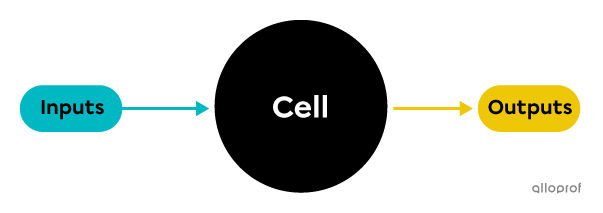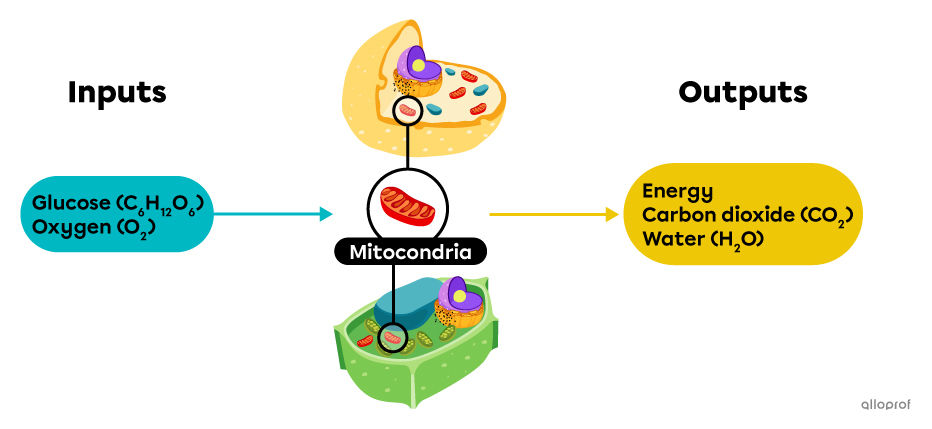Cellular exchanges take place constantly between cells and their environment to maintain the concentrations of nutrients (or other substances) and to eliminate waste. In addition, a cell can absorb or release energy in different forms. The elements introduced and released from a cell are called cellular inputs and outputs.
-
A cellular input is a substance or a quantity of energy introduced into a cell.
-
A cellular output is a substance or a quantity of energy released out of the cell.
-
Cellular exchanges are exchanges of substances and energy between cells and their environment.

-
The INputs go INside the cell.
-
The OUTputs go OUTside the cell.
During cellular exchanges, inputs and outputs move with the help of certain processes such as osmosis, diffusion, endocytosis, and exocytosis.
We can identify the cellular inputs and outputs involved in certain reactions such as cellular respiration and photosynthesis.
To provide the body with the necessary energy, animal and plant cells carry out cellular respiration. This chemical reaction takes place within the cells’ mitochondria. The reaction consumes the glucose |(\text{C}_6\text{H}_{12}\text{O}_6)| and oxygen |(\text{O}_2)| present in the cell to produce carbon dioxide |(\text{CO}_2),| water |(\text{H}_2\text{O})|, and energy.
|
Cellular Respiration |
|
|---|---|
|
Inputs |
Outputs |
|
Glucose |
Carbon dioxide |
As glucose and oxygen molecules are gradually transformed, their concentration decreases inside the cells. To maintain the reaction, the cell membrane allows new molecules to enter. Therefore, additional glucose and oxygen molecules enter the cell. They are the inputs of cellular respiration.
As carbon dioxide and water are produced, their concentration increases inside the cells. To make sure a cell survives, its cell membrane allows excess carbon dioxide and water to leave the cell. Furthermore, energy is released and made available to the organism. Since |\text{CO}_2,| |\text{H}_2\text{O}|, and energy are released from the cells during the reaction, they are the outputs of cellular respiration.

Unlike animals, plants have the ability to produce certain essential nutrients, such as glucose and oxygen |(\text{O}_2).| It is done through a photosynthesis reaction in the chloroplasts of plant cells. The reaction consumes light energy, carbon dioxide |(\text{CO}_2)|, and water |(\text{H}_2\text{O}),| to produce glucose |(\text{C}_6\text{H}_{12}\text{O}_6)| and oxygen |(\text{O}_2).|
|
Photosynthesis |
|
|---|---|
|
Inputs |
Outputs |
|
Carbon dioxide |
Glucose |
As carbon dioxide and water molecules are gradually transformed, their concentration decreases inside the cell. To maintain the reaction, the cell membrane allows new molecules to enter. This way, additional molecules of carbon dioxide and water enter the cell and react with the light energy captured by the chlorophyll of the plants. So, they are the three cellular inputs of photosynthesis.
As glucose and oxygen are produced, their concentration increases inside the cells. To maintain the balance between the concentrations inside and outside the cell, the cell membrane of plant cells allows the outflow of these substances. Glucose and oxygen are released from the cell during the reaction, which means that they are the cellular outputs of photosynthesis.

To validate your understanding of cellular exchanges in an interactive way, consult the following MiniRécup:
